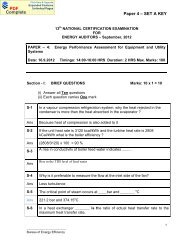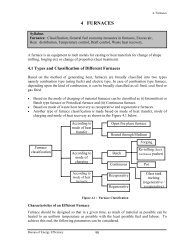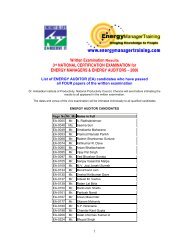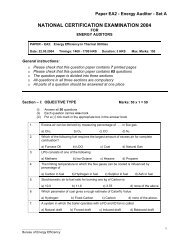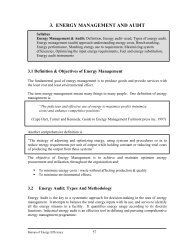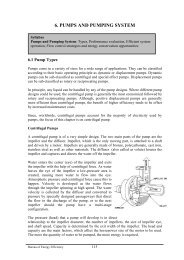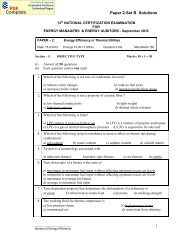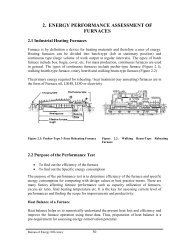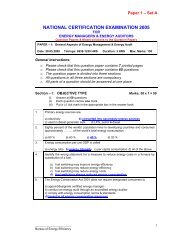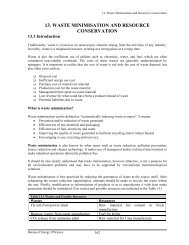Set A - National Certification Examination for Energy Managers and ...
Set A - National Certification Examination for Energy Managers and ...
Set A - National Certification Examination for Energy Managers and ...
You also want an ePaper? Increase the reach of your titles
YUMPU automatically turns print PDFs into web optimized ePapers that Google loves.
Paper EA3 – <strong>Energy</strong> Auditor – <strong>Set</strong> A<br />
NATIONAL CERTIFICATION EXAMINATION 2004<br />
FOR<br />
ENERGY AUDITORS<br />
PAPER – EA3:<br />
<strong>Energy</strong> Efficiency in Electrical Utilities<br />
Date: 23.05.2004 Timings: 0930-1230 HRS Duration: 3 HRS Max. Marks: 150<br />
General instructions:<br />
o Please check that this question paper contains 7 printed pages<br />
o Please check that this question paper contains 65 questions<br />
o The question paper is divided into three sections<br />
o All questions in all three sections are compulsory<br />
o All parts of a question should be answered at one place<br />
Section – I: OBJECTIVE TYPE Marks: 50 x 1 = 50<br />
(i)<br />
(ii)<br />
(iii)<br />
Answer all 50 questions<br />
Each question carries one mark<br />
Put a (√) tick mark in the appropriate box in the answer book<br />
1. If the voltage level of the electricity distribution system is raised from 11 kV to 33 kV<br />
<strong>for</strong> the same loading conditions, the distribution losses are reduced by a factor of<br />
a) 1/9 b) 1/3 c) 1/6 d) none of the above<br />
2. In electricity distribution, if the voltage is raised from 11 kV to 33 kV <strong>for</strong> the same<br />
loading conditions, the voltage drop in the distribution system would be lower by a<br />
factor of<br />
a) 1/4 b) 1/2 c) 1/3 d) none of the above<br />
3. If the reactive power drawn by a particular load is zero, it means the load is operating<br />
at<br />
a) lagging power factor b) leading power factor<br />
c) unity power factor d) none of the above<br />
4. Select the location of installing capacitor bank, which will reduce the electricity<br />
distribution losses to the maximum extent<br />
a) main sub-station bus bars b) motor terminals<br />
c) motor control centre d) distribution board bus bars<br />
5. A pure inductive load draws<br />
a) leading reactive power b) active power<br />
c) lagging reactive power d) none of the above<br />
_______________________<br />
Bureau of <strong>Energy</strong> Efficiency<br />
1
Paper EA3 – <strong>Energy</strong> Auditor – <strong>Set</strong> A<br />
6. The nearest kVAr compensation required <strong>for</strong> improving the power factor of a 100 kW<br />
load from 0.8 lag to unity power factor is<br />
a) 50 kVAr b) 75 kVAr c) 100 kVAr d) none of the above<br />
7. The percentage increase in power consumption of a compressor with suction side air<br />
filter pressure drop of 250 mmWC is closest to<br />
a) 0.5% b) 2% c) 3% d) 4%<br />
8. A power factor capacitor designed <strong>for</strong> 10 kVAR at 415 V was found to be operating at<br />
400 V. The effective capacity of the capacitor would be<br />
a) 9.3 kVAR b) 10 kVAR c) 10.8 kVAR d) none of the above<br />
9. A four pole induction motor operating at 50 Hz, with 1% slip will run at an actual<br />
speed of<br />
a) 1500 RPM b) 1515 RPM c) 1485 RPM d) none of the above<br />
10. With decrease in design speed of induction motors the required capacitive kVAr <strong>for</strong><br />
reactive power compensation <strong>for</strong> the same capacity range will<br />
a) increase b) decrease c) not change d) none of the above<br />
11. kW rating indicated on the name plate of an induction motor indicates<br />
a) rated input of the motor b) rated output of the motor<br />
c) maximum input power which the motor can draw<br />
d) maximum instantaneous input power of the motor<br />
12. For every 4°C reduction in the air inlet temperature of an air compressor, the power<br />
consumption will normally decrease by….. percentage points <strong>for</strong> the same output.<br />
a) 1 b) 2 c) 3 d) 4<br />
13. The acceptable pressure drop in mains header at the farthest point of an industrial<br />
compressed air network is<br />
a) 0.3 bar b) 0.5 bar c) 1.0 bar d) 2 bar<br />
14. PF capacitor installed at the motor starter location will improve<br />
a) motor design power factor<br />
b) motor operating power factor from the starter to the power supply side<br />
c) motor operating power factor from the starter to the motor terminals side<br />
d) all of the above.<br />
15. A 200 cfm compressor has a loading <strong>and</strong> unloading period of 10 seconds <strong>and</strong> 20<br />
seconds respectively during a compressed air leakage test. The air leakage in the<br />
compressed air system would be<br />
a) 20.3 cfm b) 42.1 cfm c) 66.6 cfm d) 132.8 cfm<br />
16. Higher chiller COP can be achieved with<br />
a) lower evaporator temperature <strong>and</strong> higher condensing temperature<br />
b) lower evaporator temperature <strong>and</strong> lower condensing temperature<br />
c) higher evaporator temperature <strong>and</strong> higher condensing temperature<br />
d) none of the above<br />
_______________________<br />
Bureau of <strong>Energy</strong> Efficiency<br />
2
Paper EA3 – <strong>Energy</strong> Auditor – <strong>Set</strong> A<br />
17. Vertical type reciprocating compressors are used in the capacity range of<br />
a) 50 – 150 cfm b) 200 – 500 cfm<br />
c) 500 - 1000 cfm d) above 1000 cfm<br />
18. One ton of refrigeration (TR) is equal to<br />
a) 3.51 kW b) 3024 kcal/hr c) 12,000 BTU/hr d) all of the above<br />
19. Approximate percentage reduction in power consumption with 1 °C rise in evaporator<br />
temperature in refrigerating systems is<br />
a) 1% b) 2% c) 3% d) 4%<br />
20. The refrigerant used in vapour absorption systems is<br />
a) steam b) pure water c) freon d) lithium bromide<br />
21. Li – Br water absorption refrigeration systems have a COP in the range of<br />
a) 0.4 – 0.5 b) 0.65 – 0.70 c) 0.75 – 0.80 d) none of the above<br />
22. Slip ring induction motors, in general, have a …… design efficiency in comparison<br />
with the squirrel cage induction motors <strong>for</strong> similar ratings<br />
a) lower b) higher c) same d) none of the above<br />
23. System resistance in water pumping system varies with<br />
a) square of flow rate b) cube of flow rate<br />
c) square root of flow rate d) none of the above<br />
24. The outer tube connection of the pitot tube is used to measure …… in the fan system<br />
a) static pressure b) velocity pressure<br />
c) total pressure d) dynamic pressure<br />
25. If the speed of a pump is doubled, pump shaft power goes up by<br />
a) 2 times b) 6 times c) 8 times d) 4 times<br />
26. If the speed of a pump is doubled, the pump head goes up by<br />
a) 4 times b) 2 times c) 8 times d) 16 times<br />
27. Friction loss in a piping system carrying fluid is proportional to<br />
a) fluid flow b) (fluid flow) 2 c)<br />
1<br />
fluid flow<br />
1<br />
(fluid flow) 2<br />
28. Shaft power of the motor driving a pump is 30 kW. The motor efficiency is 0.9 <strong>and</strong><br />
pump efficiency is 0.6. The power transmitted to the water is<br />
a) 16.2 kW b) 18.0 kW c) 27.0 kW d) none of the above<br />
d)<br />
_______________________<br />
Bureau of <strong>Energy</strong> Efficiency<br />
3
Paper EA3 – <strong>Energy</strong> Auditor – <strong>Set</strong> A<br />
29. For fans, the relation between flow discharge Q <strong>and</strong> speed N is<br />
2<br />
3<br />
Q<br />
1<br />
N1<br />
Q<br />
1<br />
N1<br />
Q<br />
1<br />
N1<br />
a) = b) = c)<br />
2<br />
= d) none of the above<br />
3<br />
Q2<br />
N<br />
2<br />
Q2<br />
N Q N<br />
2<br />
30. If inlet <strong>and</strong> outlet water temperatures of a cooling tower are 40 o C <strong>and</strong> 32 o C<br />
respectively <strong>and</strong> atmospheric DBT <strong>and</strong> WBT are 35 o C <strong>and</strong> 28 o C respectively then<br />
the approach of cooling tower is<br />
a) 3 o C b) 4 o C c) 5 o C d) 7 o C<br />
31. Cooling tower effectiveness is<br />
a) approach / (range + approach) b) range/ (range + approach)<br />
c) approach / range d) none of the above<br />
32. The lowest theoretical temperature to which water can be cooled in a cooling tower is<br />
a) DBT of the atmospheric air b) WBT of the atmospheric air<br />
c) average DBT <strong>and</strong> WBT of the atmospheric air<br />
d) difference between DBT <strong>and</strong> WBT of the atmospheric air<br />
33. Which of the following ambient conditions will evaporate maximum amount of water<br />
in a cooling tower<br />
a) 35 o C DBT <strong>and</strong> 25 o C WBT b) 40 o C DBT <strong>and</strong> 38 o C WBT<br />
c) 35 o C DBT <strong>and</strong> 28 o C WBT d) 38 o C DBT <strong>and</strong> 37 o C WBT<br />
34. In general, design chilled water temperature drop across chillers is approximately<br />
a) 5 o C b) 1 o C c) 10 o C d) 15 o C<br />
35. Normally a manufacturer’s guaranteed best approach of a cooling tower is<br />
a) 5 o C b) 12 o C c) 8 o C d) 2.8 o C<br />
36. GLS lamp is<br />
a) general lighting service lamp b) general lighting source lamp<br />
c) glow light source lamp d) glow light service lamp<br />
37. The unit of illuminance is<br />
a) lux b) luminaire c) lumens d) none of the above<br />
38. Luminous efficacy of which of the following is the highest?<br />
a) CFL b) HPMV c) HPSV d) LPSV<br />
39. If voltage is reduced from 230 V to 200 V <strong>for</strong> a fluorescent tube light, it will result in<br />
a) reduced power consumption b) increased power consumption<br />
c) increased light levels d) no change in power consumption <strong>and</strong> light levels<br />
40. What is the typical frequency of a high frequency electronic ballast?<br />
a) 50 Hz b) 10 kHz c) 30 kHz d) 50 kHz<br />
2<br />
2<br />
_______________________<br />
Bureau of <strong>Energy</strong> Efficiency<br />
4
Paper EA3 – <strong>Energy</strong> Auditor – <strong>Set</strong> A<br />
41. The compression ratio in diesel engines is in the range of<br />
a) 5:1 to 10:1 b) 10:1 to 13:1 c) 14:1 to 25:1 d) none of the above<br />
42. The rated efficiency of a diesel generator captive power plant has a range of<br />
a) 43% – 45% b) 50% – 60% c) 60% – 70% d) above 70%<br />
43. The maximum unbalanced load between phases should not exceed …… % of the<br />
capacity of the DG set<br />
a) 1 b) 5 c) 10 d) none of the above<br />
44. The exhaust gas waste heat recovery potential of a turbo charged genset at 500 kW<br />
loading <strong>and</strong> 480 o C exhaust gas is closest to ……<br />
(Assume exit gas temperature of 180 o C <strong>and</strong> 8 kg gas/ kWh generated)<br />
a) 1.6 lakh kCal/hr b) 2.2 lakh kCal/hr c) 3.0 lakh kCal/hr d) 3.5 lakh kCal/hr<br />
45. The operating efficiency of a DG set also depends on<br />
a) turbo charger per<strong>for</strong>mance b) inlet air temperature<br />
c) % loading d) all of the above<br />
46. The core losses of a trans<strong>for</strong>mer are the least if the core is made up of<br />
a) silicon alloyed iron (grain oriented) b) copper<br />
c) amorphous core – metallic glass alloy d) none of the above<br />
47. The basic functions of an electronic ballast fitted to a fluorescent tube light exclude<br />
one of the following<br />
a) to ignite the lamp b) to stabilize the gas discharge<br />
c) to supply power to the lamp at supply frequency<br />
d) to supply power to the lamp at very high frequency<br />
48. Modern electronic soft starters are used <strong>for</strong> motors to<br />
a) achieve variable speed b) provide smooth start <strong>and</strong> stop<br />
c) improve the loading d) none of the above<br />
49. The nearest kVA rating required <strong>for</strong> a DG set with 1000 kW connected load, with<br />
diversity factor of 1.5 <strong>and</strong> 84% loading <strong>and</strong> 0.8 power factor is<br />
a) 500 kVA b) 1000 kVA<br />
c) 1500 kVA d) 2000 kVA<br />
50. Maximum dem<strong>and</strong> controller is used to<br />
a) switch off non-essential loads in a logical sequence<br />
b) switch off essential loads in a logical sequence<br />
c) controls the power factor of the plant<br />
d) all of the above.<br />
……. End of Section – I …….<br />
_______________________<br />
Bureau of <strong>Energy</strong> Efficiency<br />
5
Paper EA3 – <strong>Energy</strong> Auditor – <strong>Set</strong> A<br />
Section – II: SHORT DESCRIPTIVE QUESTIONS Marks: 10 x 5 = 50<br />
(i)<br />
(ii)<br />
Answer all Ten questions<br />
Each question carries Five marks<br />
S-1.<br />
S-2.<br />
S-3.<br />
S-4.<br />
S-5.<br />
S-6.<br />
S-7.<br />
S-8.<br />
S-9.<br />
Calculate the trans<strong>for</strong>mer total losses <strong>for</strong> an average loading of 60%. Assume no load<br />
<strong>and</strong> full load losses as 3 kW <strong>and</strong> 25 kW respectively.<br />
(a) What is synchronous speed of an induction motor?<br />
(b) How the % slip of an induction motor is measured?<br />
How does power factor of an induction motor reduce with the reduction of the applied<br />
load on the motor? Draw a curve depicting power factor vs percentage loading on the<br />
motor.<br />
What are the parameters required to be measured while estimating the chiller<br />
per<strong>for</strong>mance in kW/TR?<br />
A fan is operating at 900 RPM developing a flow of 3000 Nm 3 /hr. at a static pressure<br />
of 600 mmWC. What will be the flow <strong>and</strong> static pressure if the speed is reduced to<br />
600 RPM.<br />
What are the various methods of flow control in centrifugal pumps?<br />
In a cooling tower, the Cycle of Concentration (C.O.C.) is 3 <strong>and</strong> evaporation losses<br />
are 1%. The circulation rate is 1200 m 3 /min. Find out the blow down quantity<br />
required <strong>for</strong> maintaining the desired level of dissolved solids in the cooling water.<br />
Whether it is advisable to install a servo trans<strong>for</strong>mer <strong>for</strong> controlling the operating<br />
voltage of the lighting circuit? Justify your answer.<br />
A 5 MW DG set with an average load of 3 MW running in parallel with the grid was<br />
found to be exporting 100 kVAr. Without calculating, explain what could be the<br />
possible reasons <strong>for</strong> the export of reactive power to the grid. List<br />
advantages/disadvantages of the above situation.<br />
S-10. How are energy savings achieved through electronic ballast in a fluorescent tube light<br />
in comparison to the conventional magnetic ballast?<br />
……. End of Section - II …….<br />
_______________________<br />
Bureau of <strong>Energy</strong> Efficiency<br />
6
Paper EA3 – <strong>Energy</strong> Auditor – <strong>Set</strong> A<br />
Section – III: LONG DESCRIPTIVE QUESTIONS Marks: 5 x 10 = 50<br />
(i)<br />
(ii)<br />
Answer all Five questions<br />
Each question carries Ten marks<br />
L-1.<br />
L-2.<br />
A plant has 2 identical 500 kVA trans<strong>for</strong>mers, each with a no load loss of 0.84 kW <strong>and</strong><br />
full load copper loss of 5.7 kW. The plant average load is 300 kVA <strong>and</strong> has never<br />
exceeded 450 kVA in the past.<br />
(a) Compare the trans<strong>for</strong>mer losses when single trans<strong>for</strong>mer is in operation <strong>and</strong> when<br />
both trans<strong>for</strong>mers are in parallel operation.<br />
(b) What would you like to advise to the plant’s management on trans<strong>for</strong>mer operation<br />
keeping in view the energy saving potential, reliability <strong>and</strong> safety of the system.<br />
A compressed air leakage test was conducted in an engineering industry, which<br />
employs a 500 cfm reciprocating compressor. The compressed air system is<br />
maintained at the normal loading-unloading settings of 6.5 kg/cm 2 g <strong>and</strong> 7 kg/ cm 2 g<br />
respectively. The following was observed <strong>for</strong> a period of 15 minutes trial:<br />
On load time = 40 secs<br />
Unload time = 120 secs.<br />
Subsequently some of the air leakage points were attended <strong>and</strong> the leakage test was<br />
repeated. The following was observed while maintaining the same loading &<br />
unloading pressure settings <strong>and</strong> trial period:<br />
On load time = 20 secs<br />
Unload time = 140 secs.<br />
The average power drawn during the above 2 trials was observed as 70 kW during<br />
load <strong>and</strong> 15 kW during unload condition. Calculate the annual cost savings <strong>for</strong><br />
5000 hr/ year of compressor operation. Assume energy charge of Rs. 5.00 per kWh.<br />
L-3. A centrifugal pump is delivering 30 m 3 /s of water at a discharge pressure of 3<br />
kg/cm 2 g. The pump suction is 1 meter below the pump center line. Find out the<br />
power drawn by the motor if the pump efficiency is 60% <strong>and</strong> motor efficiency is 92%.<br />
L-4.<br />
L-5.<br />
Briefly explain the step by step approach <strong>for</strong> the conduct of energy audit of vapour<br />
compression refrigeration plants.<br />
List 10 energy saving opportunities in a cooling tower.<br />
……. End of Section – III …….<br />
_______________________<br />
Bureau of <strong>Energy</strong> Efficiency<br />
7



